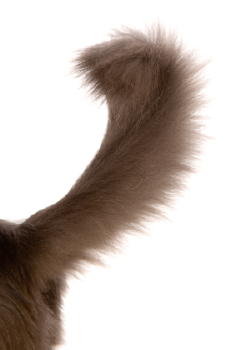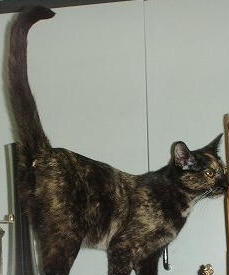Cat Tail

Although it might not be obvious, in Cat Health a cat tail is a counterbalance that adjusts your cat’s weight and helps it stay on an “even keel”. When you see your cat walking along the back of a chair, sofa or windowsill, if you watch closely you will see the tail is in motion with little twitches and curls that are helping your cat adjust its weight.
If your cat falls, it will twist around to land feet first (air-righting reflex) with its tail whipping around to fine-tune the twist. Your cat also uses the cat tail when it’s running. If your cat is a little sedentary you might not notice that when it does do a sprint it is using its tail to prevent it from tipping over as it leans into a turn.
Counterbalance isn’t unique to cats but while dogs are creatures that are land bound a cat can climb trees where they really need the extra flexibility and fine control that their tails offer. The reason that cats have more flexibility is they have between 19 and 28 tailbones (caudal vertebrae) in the cat tail, whereas the average dog tail has only 6 to 23 tailbones.
Also, cats actually have a muscle that dogs don’t have…. called the caudofemoralis muscle…located in the rump region. That muscle is the ‘tail lasher’ muscle, a movement that dogs can’t do.
The tail also is a communication device. You can read its mood and intentions by watching the tail. When a cat approaches you (or one of his feline buddies) the tail will be upright. Kittens do this when they approach their mother. The upright tail allows mom to inspect and clean the kitten’s bottom.
Your full-grown cat has learned that same greeting, a gesture to a friend. It may then quiver its tail and rub up against you, depositing an odor from sweat glands near the tail base. It’s your cat’s way of saying, “Hi, you’re okay”. If your cat is agitated, its tail sends a completely different signal…..it will twitch or lash from side to side. Long time cat owners know this means “back off”.
As expressive as tails are, they don’t tell the whole story. You have to look at the whole cat. A cat with a straight-up tail is showing confidence and friendliness. You will note that along with the upright tail the pupils are undilated, the ears are forward and the fur is smooth. However, a cat with an upright tail who has erect fur, dilated pupils and the ears are back is exhibiting fear or aggression. Even the Manx uses its stumpy tail in much the same way.

Related Articles......
Return from Cat Tail to Cat Health Homepage
Having trouble finding what you need? Cat Health Index & Site Map
OR
Do you have a question to ask?...Questions
OR
Do you have a cat story to share?...Simply click here to go to that page!
Copyright@2010-2020 All rights reserved.Cat-health-detective.com
This website is information only. Consult a veterinarian for medical assistance

"Like Us" on Facebook
or...
"Like Us" here




















